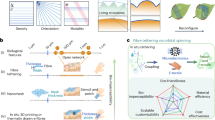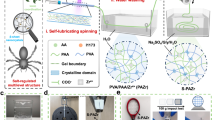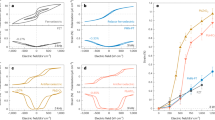Abstract
Controlling adhesion strength during and after the use of bonded materials is crucial. Dismantlable adhesives play important roles in material recycling. However, typical dismantlable adhesives rely on the bulk properties of the adhesive, and specific control of dismantling behavior is challenging. Here, we successfully demonstrated the reusability of a dismantlable adhesion interface system, in which a cleavable molecular layer forms at the adhesion interface through reversible dimerization and cleavage reactions of anthracene. The adhesion peel test was conducted repeatedly by forming a cleavable layer on the substrate surface of the specimens. Strong bonding in the initial state and easy dismantling after stimulation were achieved even in the reused layer. Our strategy for constructing a dismantlable adhesion interface holds promise in material recycling.
This is a preview of subscription content, access via your institution
Access options






Similar content being viewed by others
References
Gardner DJ. Theories and mechanisms of adhesion. In Pizzi A, Mittal KL, editors, Handbook of adhesive technology, 3rd ed., FL, USA: Taylor and Francis; 2018, pp. 3–18.
Bandl C, Wolfgang K, Schlögl S. Adhesives for “debonding-on-demand”: Triggered release mechanisms and typical applications. Int J Adhes Adhes. 2020;99:102585.
Sierra-Romero A, Novakovic K, Geoghegan M. Adhesive interfaces toward a zero-waste industry. Langmuir. 2022;38:15476–93.
Heinzmann C, Weder C, de Espinosa LM. Supramolecular polymer adhesives: advanced materials inspired by nature. Chem Soc Rev. 2016;45:342–58.
Blelloch ND, Yarbrough HJ, Mirica KA. Stimuli-responsive temporary adhesives: enabling debonding on demand through strategic molecular design. Chem Sci. 2021;12:15183–205.
Mulcahy KR, Kilpatrick AFR, Harper GDJ, Walton A, Abbott AP. Debondable adhesives and their use in recycling. Green Chem. 2022;24:36–61.
Nishiyama Y, Uto N, Sato C, Sakurai H. Dismantlement behavior and strength of dismantlable adhesive including thermally expansive particles. Int J Adhes Adhes. 2003;23:377–82.
Sato E, Hagihara T, Matsumoto A. Facile synthesis of main-chain degradable block copolymers for performance enhanced dismantlable adhesion. ACS Appl Mater Interfaces. 2012;4:2057–64.
Iseki M, Suzuki Y, Tachi H, Matsumoto A. Design of a high-performance dismantlable adhesion system using pressure-sensitive adhesive copolymers of 2‐hydroxyethyl acrylate protected with tert-butoxycarbonyl group in the presence of cross-linker and Lewis acid. ACS Omega. 2018;3:16357–68.
Akiyama H, Okuyama Y, Fukata T, Kihara H. Reversible photocuring of liquid hexa-anthracene compounds for adhesive applications. J Adhes. 2018;94:799–813.
Saito S, Nobusue S, Tsuzaka E, Yuan C, Mori C, Hara M, et al. Light-melt adhesive based on dynamic carbon frameworks in a columnar liquid-crystal phase. Nat Commun. 2016;7:12094.
Kondo M, Uematsu T, Ootsuki N, Okai D, Adachi H, Kawatsuki N. Photoinduced phase transition of N-benzylideneaniline liquid crystalline polymer and applications of photodismantlable adhesives. React Funct Polym. 2022;174:105247.
Akiyama H, Kanazawa S, Okuyama Y, Yoshida M, Kihara H, Nagai H, et al. Photochemically reversible liquefaction and solidification of multiazobenzene sugar-alcohol derivatives and application to reworkable adhesives. ACS Appl Mater Interfaces. 2014;6:7933–41.
Ito S, Akiyama H, Sekizawa R, Mori M, Yoshida M, Kihara H. Light-induced reworkable adhesives based on ABA-type triblock copolymers with azopolymer termini. ACS Appl Mater Interfaces. 2018;10:32649–58.
Xu WC, Sun S, Wu S. Photoinduced reversible solid-to-liquid transitions for photoswitchable materials. Angew Chem Int Ed. 2019;58:9712–40.
Imato K, Momota K, Kaneda N, Imae I, Ooyama Y. Photoswitchable adhesives of spiropyran polymers. Chem Mater 2022;34:8289–96.
Inada M, Horii T, Fujie T, Nakanishi T, Asahi T, Saito K. Debonding-on-demand adhesives based on photo-reversible cycloaddition reactions. Mater Adv. 2023;4:1289–96.
Shiote H, Sekiguchi Y, Ohe M, Sato C. Influence of adhesion area, applied voltage, and adherend materials on residual strength of joints bonded with electrically dismantlable adhesive. J Adhes. 2017;93:831–54.
Salimi S, Babra TS, Dines GS, Baskerville SW, Hayes W, Greenland BW. Composite polyurethane adhesives that debond-on-demand by hysteresis heating in an oscillating magnetic field. Eur Polym J. 2019;121:109264.
Kim N, Kang H, Lee JH, Kee S, Lee SH, Lee K. Highly conductive all-plastic electrodes fabricated using a novel chemically controlled transfer-printing method. Adv Mater. 2015;27:2317–23.
Babra TS, Wood M, Godleman JS, Salimi S, Warriner C, Basin N, et al. Fluoride-responsive debond on demand adhesives: manipulating polymer crystallinity and hydrogen bonding to optimise adhesion strength at low bonding temperatures. Eur Polym J. 2019;119:260–71.
Ebnesajjad S. Surface treatment of materials for adhesive bonding. 2nd ed., MA, USA: Elsevier; 2014.
Awaja F, Gilbert M, Kelly G, Fox B, Pigram PJ. Adhesion of polymers. Prog Polym Sci. 2009;34:948–68.
Kawaguchi D, Nakayama R, Koga H, Totani M, Tanaka K. Improvement of polymer adhesion by designing the interface layer. Polymer. 2023;265:125581.
Zhang Y, Hasegawa K, Kamo S, Takagi K, Takahara A. Surface modification for enhanced lap shear strength of the epoxy-bonded joints consisting of metallic adherents and similar/ dissimilar materials. ACS Appl Polym Mater. 2023;5:5381–9.
Yuk H, Zhang T, Lin S, Parada GA, Zhao X. Tough bonding of hydrogels to diverse non-porous surfaces. Nat Mater. 2016;15:190–6.
Yang J, Bai R, Chen B, Suo Z. Hydrogel adhesion: a supramolecular synergy of chemistry, topology, and mechanics. Adv Funct Mater. 2020;30:1901693.
Lee W, Heo E, Koo HB, Cho I, Chang JB. Strong, chemically stable, and enzymatically on-demand detachable hydrogel adhesion using protein crosslink. Macromol Rapid Commun. 2023;44:2200750.
Aizawa M, Akiyama H, Matsuzawa Y. Fabrication of stimulus-responsive molecular layer comprising anthracene molecules. Colloids Surf A Physicochem Eng Asp. 2021;616:126301.
Aizawa M, Akiyama H, Matsuzawa Y. Convenient preparation of stimulus-responsive molecular layers containing anthracene molecules to control surface properties. Colloids Surf A Physicochem Eng Asp. 2021;630:127547.
Aizawa M, Akiyama H, Matsuzawa Y. Dismantlable adhesion interface featuring a thermo/photocleavable molecular layer. Adv Eng Mater. 2022;24:2100823.
Aizawa M, Akiyama H, Yamamoto T, Matsuzawa Y. Photo-and heat-induced dismantlable adhesion interfaces prepared by layer-by-layer deposition. Langmuir. 2023;39:2771–8.
Bouas-Laurent H, Castellan A, Desvergne JP, Lapouyade R. Photodimerization of anthracenes in fluid solutions: (part 2) mechanistic aspects of the photocycloaddition and of the photochemical and thermal cleavage. Chem Soc Rev. 2001;30:248–63.
Frank PG, Tuten BT, Prasher A, Chao D, Berda EB. Intra-chain photodimerization of pendant anthracene units as an efficient route to single-chain nanoparticle fabrication. Macromol Rapid Commun. 2014;35:249–53.
Van Damme J, Vlaminck L, Van Assche G, Van Mele B, van den Berg O, Du Prez F. Synthesis and evaluation of 9-substituted anthracenes with potential in reversible polymer systems. Tetrahedron. 2016;72:4303–11.
Lekha PK, Prasad E. Aggregation-controlled excimer emission from anthracene-containing polyamidoamine dendrimers. Chem Eur J. 2010;16:3699–706.
Jintoku H, Kao MT, Guerzo AD, Yoshigashima Y, Masunaga T, Takafuji M, et al. Tunable stokes shift and circularly polarized luminescence by supramolecular gel. J Mater Chem C. 2015;3:5970–5.
Chatterjee S, Gohil H, Raval I, Chatterjee S, Paital AR. An anthracene excimer fluorescence probe on mesoporous silica for dual functions of detection and adsorption of mercury (II) and copper (II) with biological in vivo applications. Small. 2019;15:1804749.
Collet G, Lathion T, Besnard C, Pigust C, Petoud S. On-demand degradation of metal-organic framework based on photocleavable dianthracene-based ligand. J Am Chem Soc. 2018;140:10820–8.
ISO 472:2013. Plastics — Vocabulary. Geneva, Switzerland: ISO; 2013.
Das A, Danao A, Banerjee S, Raj AM, Sharma G, Prabhakar R, et al. Dynamics of anthracene excimer formation within a water-soluble nanocavity at room temperature. J Am Chem Soc. 2021;143:2025–36.
Acknowledgements
This work was supported by JSPS KAKENHI under grant number JP23K13808 and JST PRESTO under grant number JPMJPR21N1. This work was performed under the research programs “Dynamic Alliance for Open Innovation Bridging Human, Environment and Materials” and “Crossover Alliance to Create the Future with People, Intelligence and Materials” in the “Network Joint Research Center for Materials and Devices.”
Author information
Authors and Affiliations
Corresponding authors
Ethics declarations
Conflict of interest
The authors declare no competing interests.
Additional information
Publisher’s note Springer Nature remains neutral with regard to jurisdictional claims in published maps and institutional affiliations.
Supplementary information
Rights and permissions
Springer Nature or its licensor (e.g. a society or other partner) holds exclusive rights to this article under a publishing agreement with the author(s) or other rightsholder(s); author self-archiving of the accepted manuscript version of this article is solely governed by the terms of such publishing agreement and applicable law.
About this article
Cite this article
Aizawa, M., Akiyama, H., Matsuzawa, Y. et al. Reusable dismantlable adhesion interfaces induced by photodimerization and thermo/photocleavage reactions. Polym J 56, 401–408 (2024). https://doi.org/10.1038/s41428-023-00877-3
Received:
Revised:
Accepted:
Published:
Issue Date:
DOI: https://doi.org/10.1038/s41428-023-00877-3



